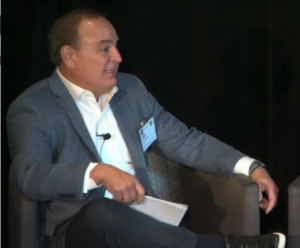 AI
AI
 AI
AI
 AI
AI
Artificial intelligence — its value, risks and utility in enterprise scenarios — not surprisingly dominated the discussion at this week’s MIT CIO Symposium, one of the year’s biggest gatherings of senior information technology executives.
Although the agenda revolved around tried-and-true topics such as digital transformation and the business value of IT, discussions invariably turned to the potential of generative artificial intelligence such as OpenAI LLC’s ChatGPT chatbot to change the way work gets done and how businesses interact with their constituents.
Battle-weary chief information officers who have years of experience dealing with technology-induced disruptions currently exhibit more trepidation than enthusiasm. They need to prepare for “a potential flood of regulations coming your way,” warned Stuart Madnick, professor of information technology at the MIT Sloan School of Management. “The bad guys are getting badder, which means the good guys have to get better.”
There is no question that AI is going to change the workplace. “The future of work will be profoundly different from what we all have experienced,” said Mike Grandinetti, a serial entrepreneur and faculty director of the postgraduate program in innovation leadership at Brown University.
Most CIO speakers said their organizations are still grappling with how to apply generative AI, although many have been using AI algorithms for tasks such as predictive analysis and workload optimization for years.

Deloitte’s Kapreillian: “There is a myth that AI capabilities will differentiate companies.”
“There is this myth that AI capabilities will differentiate companies,” said Sam Kapreillian, a principal at Deloitte LLP. “I predict in five years everyone will be using it. The challenge is being about to apply AI to your various business processes and use it for mission-critical activities.”
Several CIOs said their organizations are already using AI for spot projects with good success. Carmax Enterprise Services LLC is using ChatGPT to help organize customer car reviews to make them more useful in informing customers about automotive purchases. The Travelers Indemnity Co. is using AI to improve underwriting calculations and offer better prompts for its customers to describe post-disaster home conditions.
Citigroup Inc. saw an unprecedented decline in customer complaints after it applied AI to analyze call center patterns and identify the most common problems service representatives encountered. Food service giant Sysco Corp. is experimenting with AI to better understand customer needs and streamline the ordering process. Those were just a few of the mentions of AI throughout the conference.
ChatGPT is at the peak of the hype cycle and CIOs have to be the reality checks against overexuberance, speakers said. The current generative AI feeding frenzy has put CIOs in a position that’s akin to managing a team of eight-year-old soccer players, said John Allen, vice president of cyber risk and compliance at threat intelligence vendor Darktrace Holdings Ltd.
When there is a breach, there is this swarm around any new shiny thing, just like the kids swarm around the ball,” he said. “The trick is being able to shift away from the swarm and work with your CISO [chief information security officer] on understanding your risk exposure and how you can adapt and recover from the attack.”
The potential security risk of AI was a frequent topic of discussion. “IT and security need to work together,” said Bill Brown, who wears both hats at Abacus Insights, Inc. a Boston-based healthcare analytics firm. “You should be prepared to respond when things change and have planned for all sorts of contingencies. This means doing lots of role-playing and crafting scenarios, thinking about what could go wrong.”
Part of being resilient is accepting the inevitability that “eventually you will be breached,” Allen said. Board-level awareness of risks and the protective measures the IT organization is taking is crucial.
Resilience is also about learning how to be an agile organization. “We have to make our entire company more agile,” said Shamim Mohammad, chief information and technology officer at CarMax. “It isn’t just about doing cool things with technology, but building the right partnerships with various executives across the company.”
Part of this journey is being able to “ask why we need to be agile, and how we can deliver new capabilities to our customers,” said Subhada Reddimasi, chief architect at Wells Fargo Bank N.A. “We need to quickly respond to changes in our business,” said Lefebvre at Travelers. “We now think of ourselves as a business software company that is centered on our customers. That means we have to bring an agile mindset into the entire organization.”
Equally important is defining the opportunities to apply AI for business value, since money is easily wasted on science experiments in these early days. “More than before, the CIO has to be more business oriented and talk the language of the board of directors,” Grandinetti said.
“You have to make sure both of you are aligned with business objectives,” said Mojgan Lefebvre, executive vice president and chief technology and operations officer at The Travelers Cos. Inc. “We now stand at the intersection of operations and strategy, and we have to take advantage of them both.”
Ashish Grover, CIO for Falabella SPA, a Chilean retail conglomerate, calls this being a “full stack leader” who can understand the broadest consequences of the business and the necessary component technologies. Part of this concept is understanding how quantifying risk has evolved for both for the business at large and for the IT department itself.
Finally, Deepa Soni, CIO for The Hartford Financial Services Group Inc. mentioned a new term for CIOs to rally around. “We have to start thinking in terms of what is the minimum lovable product.” That’s an alternative to the minimum viable product term that has been often used as the basis of innovation, showing IT leaders have to be more passionate about what they’re working on for the future.
“I consider digital transformation to be my job, and to leverage as much technology as we can to achieve our business outcomes,” said Travelers’ Lefebvre.
Living with AI and its large language model tools will certainly become more important as they get more features and integrate with various business data repositories. But maybe making them lovable will prove to be a good next step.
THANK YOU